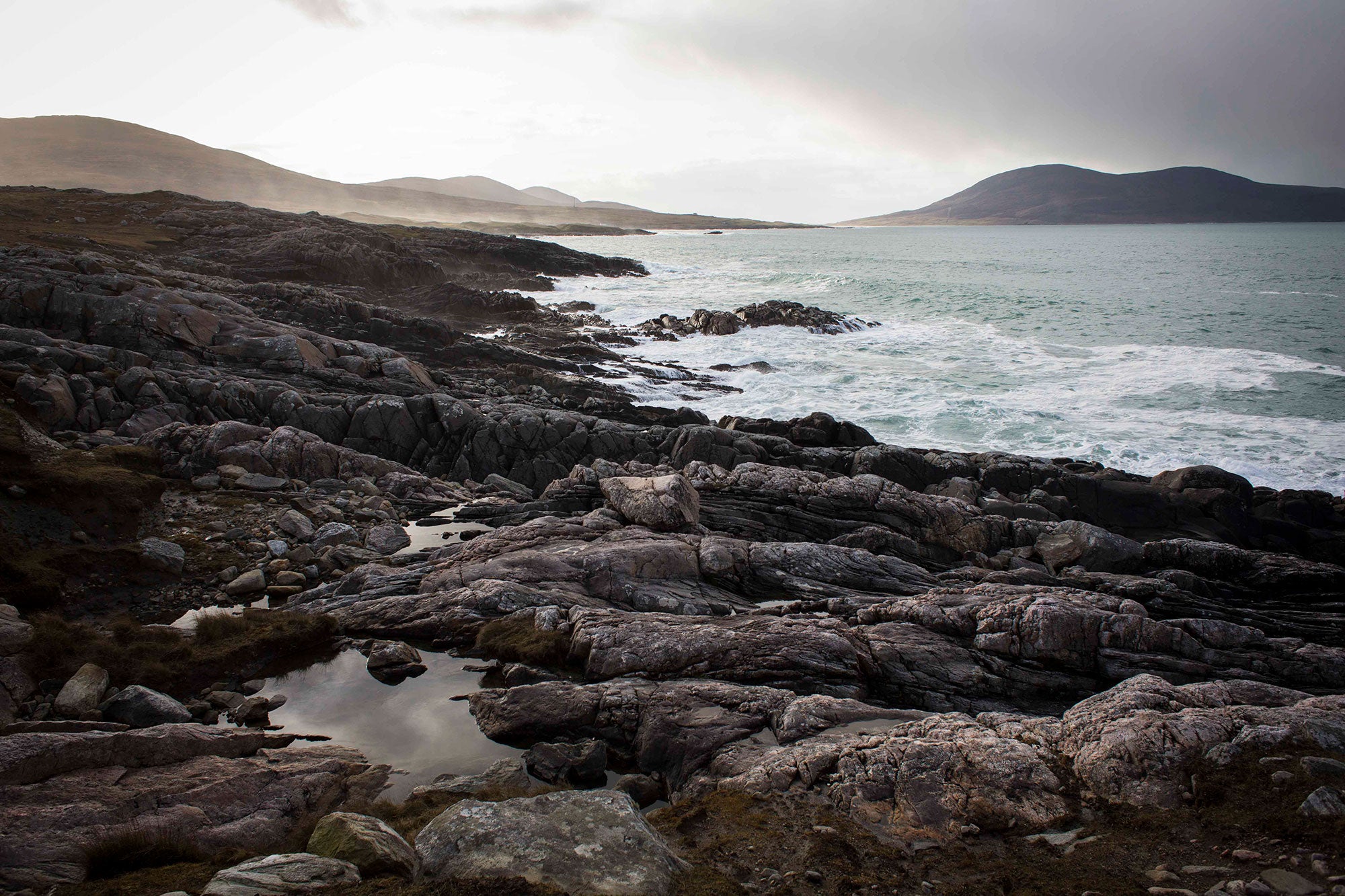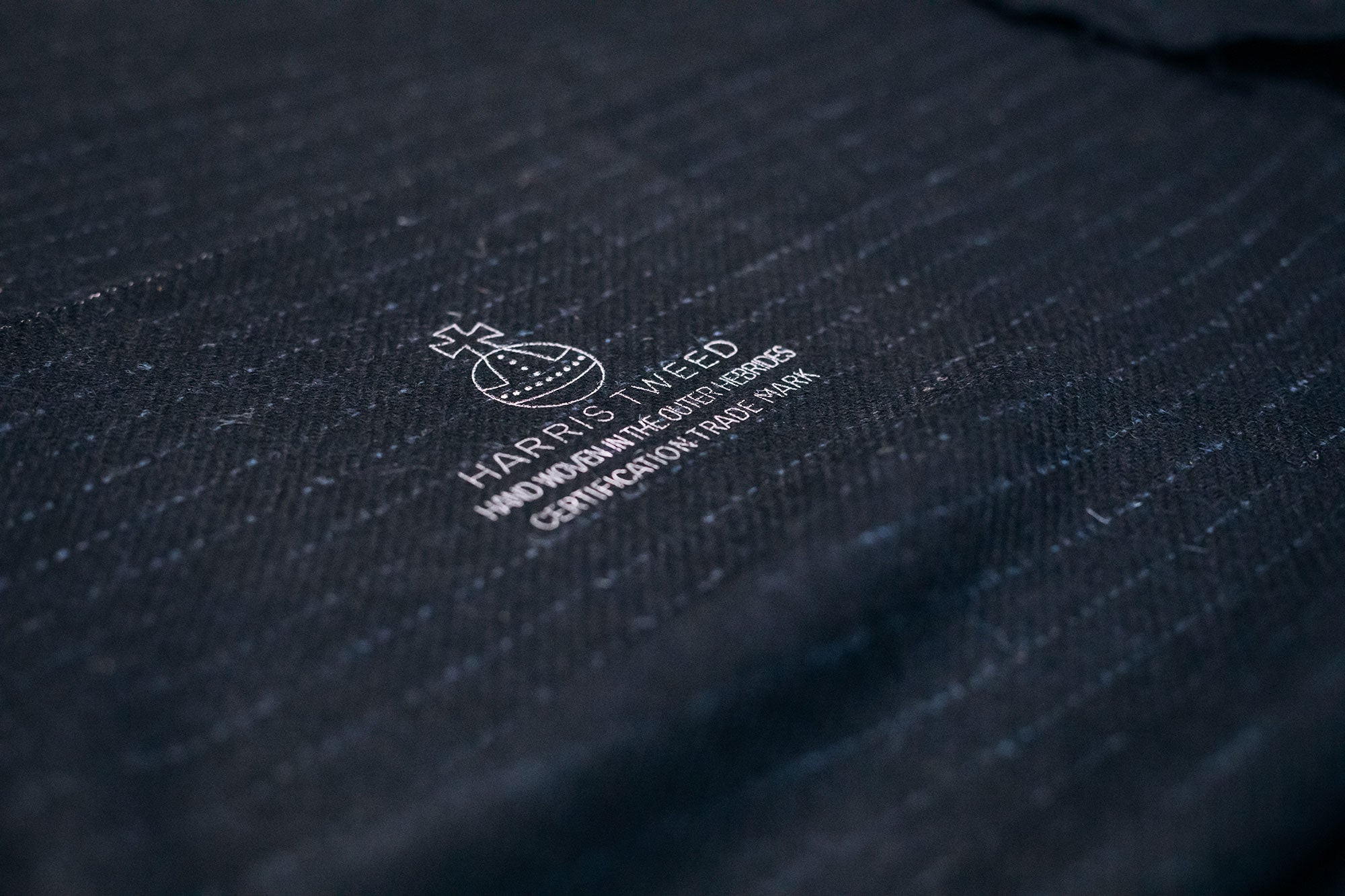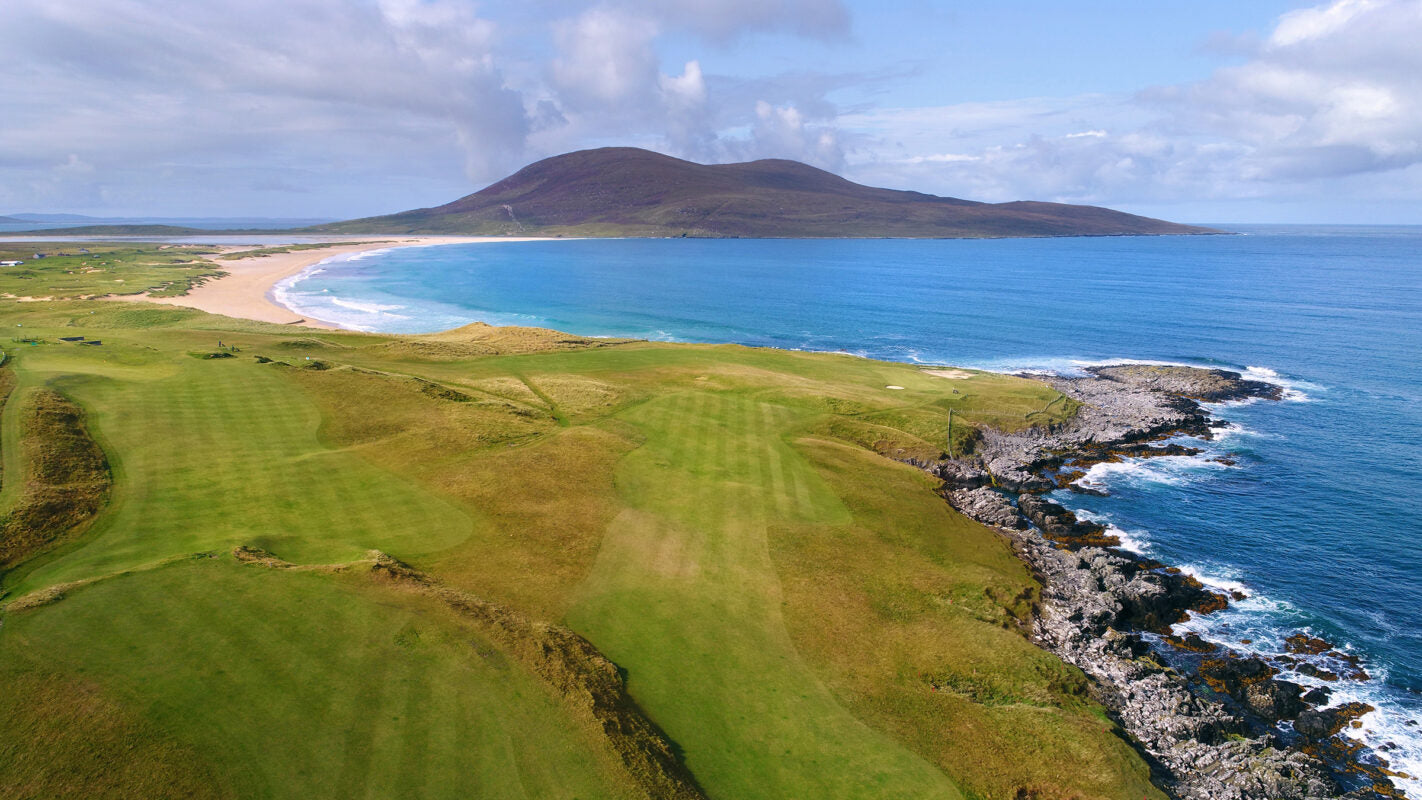Interview with Mark Hogarth:
Creative Director of Harris Tweed Hebrides

In a wide ranging conversation, we bring you an interview/chat with Mark Hogarth covering the essence of Harris Tweed, the change in Golf and the shared history with Harris Tweed, Scottish textiles and manufacturing plus the inspiring places of Scotland. Mark has been the long time Creative Director of Harris Tweed Hebrides and has overseen a transition of modernisation of the brand and the implementation of various contemporary projects and collaborations.
FG: Thanks for taking the time to chat with us, I see you have your cycling gear ready?
MH: "I’ll be getting on the bike and heading to the hills. The north of Glasgow is great for road biking, you can clear the city in 5 sets of traffic lights. I'll be going up through Maryhill and into Possil, up through Strathblane past the Glengoyne Distillery and come back through Killearn and up Crow Road"
Due to an old back injury and, as he admits himself, golf is the only sport he doesn’t have a natural talent at. This has halted playing time on the course. But growing up in Ayshire and spending much time in Arran, he played a fair bit in his younger days on the Island. He foresees playing golf in his 50’s, but for now cycling is for his 40’s. “The back is getting better, so I will leave it to my 50’s. All my mates play and do golfing holidays which seem a lot of fun”
FG: The direction of golf is changing from the new wave of brands that have entered the market and a change of attitude, a more modern approach to the game. What have you seen from your vantage point?
MH: "Working with FootJoy was a real eye opener (Footjoy recently released a Blackwatch Harris Tweed detail golf shoe), to see their output and their ability to see the demographic and the changing landscape. I’ve seen the likes of Macklemore’s Bogey Boys and I’ve know what Cathal has been doing (Founder of Sounder Golf) and I’ve seen some of the younger brands. I knew this from my time in Japan, in terms of the modernisation of the game; Japanese golf was haemorrhaging interest because it was becoming so elite and become a victim of its snobbery. Clubs changed that by introducing heavily discounted memberships, the media started to highlight that golf was becoming a dying sport in the country and it got a bit of a bounce back."
FG: It was almost a democratisation of golf which I think also gave permission for streetwear and fashion influences in golf and an openness to play with the dress code. We recently had a chat with Mid 90’s Tokyo Club (mid90sclub.com) and they were saying how much it had changed, but they still wanted to ensure they were respectful to the heritage alongside promoting a more modern approach. In many respects, it’s how we aim to combine heritage makers, mills, and factories in Scotland with a modern, sustainable design approach.
MH: "I think it’s great to see what Fyfe is doing in fusing heritage fabrics and manufacturing with moreder, sustainable designs...and great to see so many factories in Scotland making a bit of a comeback. Harley’s (the specialised knitwear factory in Aberdeenshire) is doing really well. And good for them as I know they were struggling for a long long time, and they’ve not done anything drastic, they’ve just doubled down on their heritage, but you’ve seen some of the luxury brands starting to be more open about their supply chain and hence, Harley’s has received some more exposure which has helped them.
It's also interesting to see the Crombie brand has been bought out and hopefully the new owners can re-establish that…imagine having a propriety name of a coat, some provenance there to play with.
There is almost a synergy with the renaissance of Scottish manufacturing and the renaissance of golf. The guys at FootJoy were saying that during the lockdown period, the two sports that participation increased the most was golf and cycling being intrinsically tied to the outdoors."
"There is almost a synergy with the renaissance of Scottish manufacturing and the renaissance of golf."
FG: What do you think is behind the renaissance of Scottish manufacturing?
MH: "I think it’s being driven by this generation. If you think, globalisation kicked in the 70’s, people will remember the miners and all the rest of it, miners losing their jobs in the 80’s but compared to the amount of textile and garment makers that lost their jobs it was miniscule. 4 million textile jobs went between 1974 to 1990, of which 60% were women. So I think one my theories is that, we’ve just caught the end of that, so the people that started working in their twenties and thirties learning the trade that are now in their sixties are so enthusiast to see these skills continue. I see that a lot in the borders which is where the majority of the factories we work with are located, alongside some of the other factories in central areas of Scotland."
FG: With Harris Tweed, the heritage is obviously important. How is that maintained and controlled and what are its links with golf?
MH: "The Harris Tweed Authority is the umbrella organisation that has the remit of holding Harris Tweed intact for the next generation of Islanders, which is an admirable and aspirational remit. In many ways it’s similar to the R&A, an organisation which is there to protect the values, rules and regulations of golf. So because of the heritage elements and the 19th century timing, golf came to the fore in the 19th century, Harris Tweed came to the fore in the 19th century. You have all these incredible images of Old Tom Morris, walking around sand dunes designing golf courses but of course, dressed in Harris Tweed…the perfect performance sportswear of the day, protecting you from the wind and cold.
There are also some plans for in place for the 150th Open which will be announced closer to the time which in part celebrates this link."
FG: Have you seen an increase in demand for Harris Tweed in recent years?
MH: It’s really interesting, over the past 50 years it’s been a cliched rollercoaster. If you speak to the mills and those involved over the years, they would describe it as a bit of a boom and bust and what is known as the 7 year cycle. The 7 year cycle is, you start building a bit of business in the first couple of years, then you get on a trend for a 3-4 years where there is serious demand and then it would dissipate. But that’s because we only really used to deal with Men’s jackets which was partly trend led and a lot of business from a very specific market in US. I’m not sure if this is a pejorative term now, but the WASP market, the white Anglo Saxon Presbyterian market on the east board, created a demand from the Ivy league…but our aim is to continue move away from the reliance of this, away from the fashion element and create patterns that customers can come back to season after season.
So in other words Harris Tweed ceases to be trend item, but instead we offer a number of patterned cloths that fit into other people’s trend lines. And I think it’s really worked, we’ve seen the use of Herringbones in the hipster movement, but then the Japanese market came and are crazy for patterns so our plaids have done really well. Our integrity in the production process, we dye the wool, not the yarn, we are a fully integrated mill meaning wool comes in, cloth goes out, but of course we have this incredible star performer in the middle of that; the fact its hand woven at the individual home of the weaver. That allows such a variance of pattern, even the plain melange clothes which do well with the Parisian or Milanese fashion houses, they want Harris Tweed to look like Harris Tweed, and the plains can be more easily used in these ranges…many times we’ve had the experience that the design teams feel their collection is too flat and needs some different fabrics to add more texture and vibrancy, and Harris Tweed is seen as a great way to bring their ranges to life. I remember, a chap came over from YSL, flight Paris to Glasgow, Glasgow to Stornoway and then a taxi over to the mill, he picked a beautiful charcoal Harris Tweed, he was straight back in the taxi and onto the next flight back to Paris and he and the fabric ended up on the cutting floor at their design studio that evening and the fabric was used in a fashion show 5 days later. So that’s why I think Harris Tweed will always have a part to play because what we do is completely unique.
And more recently, we have done projects with New Balance, Beams Japan & Todd Snyder in the US. The more contemporary brands have incorporated the Harris Tweed heritage into their range which has been great and it’s been a focus for us to ensure we are relevant to a modern demographic.
What people get when they use Harris Tweed, it’s not just a piece of textured wool, but a whole narrative as the fabric had been made with care, on a hand loom consuming no electricity in the Outer Hebrides of Scotland and more recently in the fashion industry, it’s not what you are making but it’s how you are making it that has become more important. And that’s where Harris Tweed will have an infinite part to play.
"You have all these incredible images of Old Tom Morris, walking around sand dunes designing golf courses but of course, dressed in Harris Tweed…the perfect performance sportswear of the day, protecting you from the wind and cold."
FG: That creates a great segway into another question. Are there any additional or new measures being taken with the Harris Tweed industry to be even more sustainable?
MH: "That’s a very good question. We have to work within the parameters of the Act of Parliament 1993, which is a 93-page document, however within that we do generally follow the whole dynamic of Kaizen in that we are always trying to be that little bit better. We have always had a zero waste policy, and we are finding ways to get better at recycling wool, so in spillages that are going through the mill are being better utilised. We have invested £1.8m in a new dye house facility and the new machinery is more energy efficient."
FG: And in general, what are the future plans for Harris Tweed Hebrides?
MH: "Well, we are not like a normal company where growth, becoming bigger and richer and keeping shareholders happy is the ambition. That’s never been a part to play in Harris Tweed, partly because the industry is tied in with the Islanders that can never be taken away from the Islands, so the responsibility dimension is far more important than making more profit. What we have to do, and our challenge is to find new and exciting things as a heritage fabric proposition, so we work a lot on different types of finishing, it’s amazing how the slight variations in the production process can have on the hand feel of the fabric. And of course, design, we will often go back to the 1920’s and 30’s archive books for inspiration. It’s small iterations that we work on alongside always focusing on creating the best possible product.
For me, a good analogy is the Pirella tyre, it’s a component of high quality and you’ll find it on Ferrari’s, Maseratti’s…like a luxury component. Harris Tweed will always have a place, whether it be used on Ralph Lauren, Vivienne Westwood or a Dior. That’s what we are renowned for and where we fit best."

"within that we do generally follow the whole dynamic of Kaizen in that we are always trying to be that little bit better."
FG: More broadly, Scotland has such a rich heritage in the creation of textiles. What do you think has driven this in the past, what is it in the culture that inspires the people of Scotland?
MH: "Being away from Scotland over the years having lived in Japan, Australia and in London for a while, you see the landscape of Scotland from a different perspective and see more clearly how the nature of Scotland begets the design of the fabrics. The Hebrideans have a saying “from the land comes the cloth”. There is a clear symbiosis between the land, the culture and the people. The landscape inspires.
Recently I went to the borders and through Selkirk, Locharran, it was fascinating. There are some fairly large distances between each village, so each one has its own identity. But what ties them all together is this incredible river where many mills exist. So, there was green grass, sheep and this fast-flowing river that allowed spinning mills to be created and ultimately weave textiles. It’s a natural heritage and as you say, Scotland has a talent for crafting textiles. "
"There is a clear symbiosis between the land, the culture and the people. The landscape inspires."
FG: Staying on the landscapes of Scotland, is there a favourite place you like to visit, a place to re-energise or a place you find most inspiring?
MH: "It’s a really good question. I’m from Ayshire, so spent a lot of time in Arran which I’m fond of, but I wouldn’t say there is one particular place, there is just a multitude of places to go. I am lucky, my partners parents have a place in Elie, so that’s been a good staging post in the last couple of years and we have a house still in Arran. There is something about going to the Islands, it’s almost as soon as you step onto the Islands, things go slower, you feel less pressure and it’s the same with the Scottish countryside. Almost with less people and more nature you start to think differently and gain a sense of clarity and come up with some great ideas. "

"There is something about going to the Islands, it’s almost as soon as you step onto the Islands, things go slower, you feel less pressure"
FG: One last question, what books have you most often recommended or given?
MH: "There is a book I’ve read 3 times and something I often discuss with my father which is called Eastern Approaches by Fitzroy McLean. On a fundamental level I have nothing in common with him, he was Tory MP and grew up in a lot of privilege, but he was probably one of the most remarkable people to have ever walked the earth, certainly in his era. He became involved in the military and explored much of Eastern Europe. Through his eyes you get an insight into Stalin’s Russia. He also became Churchill’s man in Yugoslavia. It’s book full of adventure told in a way which is very entertaining and a great reference to a bygone era."


